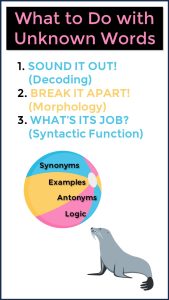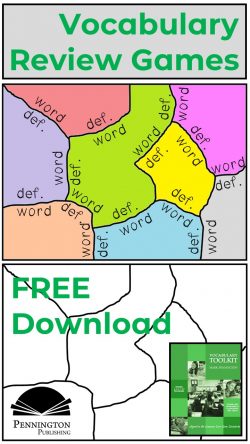
Comprehensive Vocabulary
Memorizing vocabulary word parts is essential to academic vocabulary acquisition. However, memorization can present a problem for many students. Spending class time practicing vocabulary memorization may seem, on the surface, a waste of valuable time. After all, doesn’t memorization all come down to study and practice? True, but most of us were not born already knowing how to study and practice. In fact, many students have never learned how to study effectively, and many do not have home environments that are conducive to sufficient practice.
Good teachers know that we have to teach both content and process. The goal may be to get students to learn their vocabulary word parts (the content), but teaching a variety of study techniques to learn those word parts helps students learn valuable critical thinking skills (the process). As a bonus, taking the time to model practice routines in the classroom will help instill habits that will carry over to homework.
Students are more likely to use study and practice procedures that are “game-like” and less boring than simple rote memorization. Here are some fun and effective vocabulary word part review games. Also, check out Vocabulary Review Games for more.
Word Part Brainstorming
After introducing the week’s word parts (such as Greek and Latin) morphemes) and their definitions, ask students to brainstorm words that they already know that use each of the word parts. Give students two minutes to quick-write all of these words that use the selected prefix, root, or suffix. Then, ask students to share their words in class discussion. On the board or display projector, write down student examples that clearly use the definition that you have provided. Require students to write down each word that you have written in a vocabulary journal. Award points for all student contributions.
Inventive Vocabulary Writing
After introducing the week’s word parts and their definitions, ask students to invent words that use each word part in a sentence that uses context clues to show the meaning of each nonsense word. Encourage students to use “real” word parts to combine with each targeted word part to form multi-syllabic words. Award extra points for words used from prior week’s words.
For variety, require students to write in different genre. Examples: brief narratives, classified ads, game directions, how-to paragraphs, dialogs, journals, advice columns.
Put-Togethers
This game can be played once the teacher has introduced a sufficient number of word parts and the students have created Vocabulary Study Cards. Students spread out their cards into prefix, root, and suffix groups. The object of the game is to put together these word parts into real words within a given time period. Students can use connecting vowels. Students are awarded points as follows:
1 point for each prefix—base combination
1 point for each base—suffix combination
2 points for a prefix—base combination that no one else in the group has
2 points for a base—suffix combination that no one else in the group has
3 points for each prefix—base—suffix combination
5 points for a prefix—base—suffix combination that no one else has.
Word Part Monsters
This three-day activity works well before Halloween or Open House to get student art work up on the board—oh, and it also is a fun word part review activity. Tell your students that they will create their own Word Part Monsters from their Vocabulary Study Cards. Make a transparency copy of the following directions and models.
Directions
Day 1
1. Quick draw, in pencil, two rough-draft monsters, using at least three prefixes, roots, or suffixes from your Vocabulary Study Cards.
2. Write the name of your monsters, using the word parts, at the bottom of each drawing. Feel free to use connecting vowels to tie together the word parts.
Day 2
3. Choose one of your quick-draw monsters and neatly draw and color it on construction paper.
4. Write the monsters’ name on the back, using the word parts. Turn in your monster to the teacher. Don’t turn into a monster for your teacher.
Day 3
5. The teacher has numbered all of the monsters and posted them around the room. Number a sheet of binder paper and write down all of the monster’s names next to the correct number.
Option A (challenging)—Choose from the monster names that the teacher has written on the board.
Option B (very challenging)— Choose from the monster names that the teacher has written on the board and use the definitions to write a sentence, describing what the monster is like.
Option C (very, very challenging)—The teacher does not write down the monster names on the board. You have to figure them out based upon the drawings alone.
6. The winner(s) are the students who identify the most monsters correctly.
*****
For full-year vocabulary programs which include multiple meaning words (L.4.a.), Greek and Latin morphology with Morphology Walls (L.4.a.), figures of speech (L.5.a.), words with special relationships (L.5.b.), words with connotative meanings (L.5.c.), and academic language words (L.6.0), check out the assessment-based grades 4, 5, 6, 7, and 8 Comprehensive Vocabulary.
Get the Grades 4,5,6,7,8 Vocabulary Sequence of Instruction FREE Resource:

Get the Greek and Latin Morphology Walls FREE Resource:

Get the Diagnostic Academic Language Assessment FREE Resource:

Reading, Spelling/Vocabulary, Study Skills, Writing
base words, Greek and Latin, Greek and Latin Morphology, Greek and Latin word parts, Mark Pennington, morphemes, morphological awareness, morphology walls, Teaching the Language Strand, vocabulary, vocabulary flash cards, vocabulary flashcards, vocabulary instruction, vocabulary memorization, vocabulary practice, vocabulary skills, vocabulary worksheets, word lists, word parts

![]()
![]()


